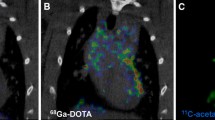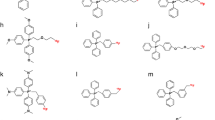Abstract
Background
Positron emission tomography (PET) has clear advantages over single photon emission computed tomography (SPECT) in the field of myocardial perfusion scintigraphy (MPS); however, there are just a small number of efficient PET tracers available today for MPS. We sought to develop and perform a preliminary biological evaluation of novel carbon-11-labeled ammonium salts as potential MPS PET agents.
Methods and Results
Three potential tracers were labeled and evaluated via biodistribution in mice and PET imaging in both rats and rabbits, and the results obtained were also compared to agents that are routinely used in the clinical practice.
Conclusions
The results designated carbon-11-labeled ammonium salts as having great potential as MPS PET agents. Specifically, carbon-11-labeled trimethyl-phenyl-ammonium iodide ([11C]2) and homologues of higher lipophilicity/charge warrant further studies in larger animals and humans such as measurements of myocardial uptake at rest and stress under both normal and pathological coronary flow conditions.









Similar content being viewed by others
References
Beller GA (2003) First annual Mario S. Verani, MD, Memorial lecture: clinical value of myocardial perfusion imaging in coronary artery disease. J Nucl Cardiol 10(5):529–542
Hachamovitch R, Berman DS, Kiat H et al (2002) Value of stress myocardial perfusion single photon emission computed tomography in patients with normal resting electrocardiograms: an evaluation of incremental prognostic value and cost-effectiveness. Circulation 105(7):823–829
Marcassa C, Bax JJ, Bengel F et al (2008) Clinical value, cost-effectiveness, and safety of myocardial perfusion scintigraphy: a position statement. Eur Heart J 29(4):557–563
Russell RR 3rd, Zaret BL (2006) Nuclear cardiology: present and future. Curr Probl Cardiol 31(9):557–629
Underwood SR, Shaw LJ, Anagnostopoulos C et al (2004) Myocardial perfusion scintigraphy and cost effectiveness of diagnosis and management of coronary heart disease. Heart 90(Suppl 5):v34–v36
Rahmim A, Zaidi H (2008) PET versus SPECT: strengths, limitations and challenges. Nuc Med Comm 29(3):193–207
Knaapen P, Lubberink M (2008) Cardiac positron emission tomography: myocardial perfusion and metabolism in clinical practice. Clin Res Cardiol 97(11):791–796
Parkash R, deKemp RA, Ruddy TD et al (2004) Potential utility of rubidium 82 PET quantification in patients with 3-vessel coronary artery disease. J Nucl Cardiol 11(4):440–449
Yoshinaga K, Katoh C, Noriyasu K et al (2003) Reduction of coronary flow reserve in areas with and without ischemia on stress perfusion imaging in patients with coronary artery disease: a study using oxygen 15-labeled water PET. J Nucl Cardiol 10(3):275–283
Aarnoudse WH, Botman KJ, Pijls NH (2003) False-negative myocardial scintigraphy in balanced three-vessel disease, revealed by coronary pressure measurement. Int J Cardiovasc Interv 5(2):67–71
Dahlberg S, Leppo J (2003) Risk stratification of the normal perfusion scan: does normal stress perfusion always mean very low risk? J Nucl Cardiol 10(1):87–91
Lima RS, Watson DD, Goode AR et al (2003) Incremental value of combined perfusion and function over perfusion alone by gated SPECT myocardial perfusion imaging for detection of severe three-vessel coronary artery disease. J Am Coll Cardiol 42(1):64–70
Ragosta M, Bishop AH, Lipson LC et al (2007) Comparison between angiography and fractional flow reserve versus single-photon emission computed tomographic myocardial perfusion imaging for determining lesion significance in patients with multivessel coronary disease. Am J Cardiol 99(7):896–902
Berman DS, Kang X, Slomka PJ et al (2007) Underestimation of extent of ischemia by gated SPECT myocardial perfusion imaging in patients with left main coronary artery disease. J Nucl Cardiol 14(4):521–528
Takaro T, Hultgren HN, Lipton MJ, Detre KM (1976) The VA cooperative randomized study of surgery for coronary arterial occlusive disease II. Subgroup with significant left main lesions. Circulation 54(6 Suppl):III107–III117
Travin MI (2007) Is it possible for myocardial perfusion imaging to avoid missing any patients with high-risk coronary disease? J Nucl Cardiol 14(4):492–496
Carlin RD, Jan KM (1985) Mechanism of thallium extraction in pump perfused canine hearts. J Nucl Med 26(2):165–169
DePuey EG, Garcia EV, Berman DS (2000) Cardiac SPECT imaging. Lippincott Williams & Wilkins, Philadelphia
Schwaiger M (1994) Myocardial perfusion imaging with PET. J Nucl Med 35(4):693–698
Rauch B, Helus F, Grunze M et al (1985) Kinetics of 13N-ammonia uptake in myocardial single cells indicating potential limitations in its applicability as a marker of myocardial blood flow. Circulation 71(2):387–393
Korsakov MV, Krasikova RN, Fedorova OS (1996) Production of high yield [N-13]ammonia by proton irradiation from pressurized aqueous solutions. J Radioanal Nucl Chem-Artic 204(2):231–239
van den Hoff J, Burchert W, Borner AR et al (2001) [1-(11)C]Acetate as a quantitative perfusion tracer in myocardial PET. J Nucl Med 42(8):1174–1182
Williams G, Kolodny GM (2009) Retrospective study of coronary uptake of 18F-fluorodeoxyglucose in association with calcification and coronary artery disease: a preliminary study. Nuc Med Comm 30(4):287–291
Huisman MC, Higuchi T, Reder S et al (2008) Initial characterization of an 18F-labeled myocardial perfusion tracer. J Nucl Med 49(4):630–636
Yu M, Guaraldi M, Kagan M et al (2009) Assessment of F-18-labeled mitochondrial complex I inhibitors as PET myocardial perfusion imaging agents in rats, rabbits, and primates. Eur J Nucl Med Mol Imaging 36(1):63–72
Madar I, Ravert H, Nelkin B et al (2007) Characterization of membrane potential-dependent uptake of the novel PET tracer 18F-fluorobenzyl triphenylphosphonium cation. Eur J Nucl Med Mol Imaging 34(12):2057–2065
Madar I, Ravert HT, Du Y et al (2006) Characterization of uptake of the new PET imaging compound 18F-fluorobenzyl triphenyl phosphonium in dog myocardium. J Nucl Med 47(8):1359–1366
Marshall RC, Powers-Risius P, Reutter BW et al (2004) Kinetic analysis of 18F-fluorodihydrorotenone as a deposited myocardial flow tracer: comparison to 201Tl. J Nucl Med 45(11):1950–1959
Crouzel C, Långström B, Pike VW, Coenen HH (1987) Recommendations for a practical production of [11C]methyl iodide. Int J Radiat Appl Instrum Appl Radiat Isot 38(8):601–603
Mishani E, Ben-David I, Rozen Y et al (2001) [C-11] choline-automated preparation and clinical utilization. J Label Compd Radiopharm 44:S379–S381
Kim SW, Yang SD, Ahn BJ et al (2005) In vivo targeting of ERG potassium channels in mice and dogs by a positron-emitting analogue of fluoroclofilium. Exp Mol Med 37(4):269–275
Studenov AR, Berridge MS (2001) Synthesis and properties of 18F-labeled potential myocardial blood flow tracers. Nucl Med Bio 28(6):683–693
Burns HD, Marzilli LG, Dannals RF et al (1980) 4-[125I] iodophenyltrimethylammonium ion, an iodinated acetylcholinesterase inhibitor with potential as a myocardial imaging agent. J Nucl Med 21(9):875–879
Huang CC, Friedman AM, Rayudu GV, Clark P, Fordham EW (1980) In vivo stability and distribution of [131I]iodomethyl trimethylammonium chloride: concise communication. J Nucl Med 21(7):679–681
Tsubaki H, Nakajima E, Shigehara E, Komai T, Shindo H (1986) The relation between structure and distribution of quaternary ammonium-ions in mince and rats—simple tetraalkylammonium and a series of m-substituted trimethylphenylammonium ions. J Pharmacobio-Dyn 9(9):737–746
Hansch C, Leo A (1987) Log P Database. Pomona College Medicinal Chemistry Project, Claremont, CA 91711
Fowler JS, Gallagher BM, MacGregor RR, Wolf AP (1976) Carbon-11 labeled aliphatic amines in lung uptake and metabolism studies: potential for dynamic measurements in vivo. J Pharmacol Exp Ther 198(1):133–145
Hang LW, Shiau YC, Hsu WH et al (2003) Increased lung uptake of technetium-99m hexamethylpropylene amine oxime in diffuse infiltrative lung disease. Respiration 70(5):479–483
Poulsen LL, Taylor K, Williams DE, Masters BS, Ziegler DM (1986) Substrate specificity of the rabbit lung flavin-containing monooxygenase for amines: oxidation products of primary alkylamines. Mol Pharmacol 30(6):680–685
Acknowledgments
Ohad Ilovich’s research was generously supported by the Hoffman Leadership and Responsibility fund, at the Hebrew University.
Author information
Authors and Affiliations
Corresponding author
Rights and permissions
About this article
Cite this article
Ilovich, O., Billauer, H., Dotan, S. et al. Novel and Simple Carbon-11-Labeled Ammonium Salts as PET Agents for Myocardial Perfusion Imaging. Mol Imaging Biol 13, 128–139 (2011). https://doi.org/10.1007/s11307-010-0336-7
Published:
Issue Date:
DOI: https://doi.org/10.1007/s11307-010-0336-7




